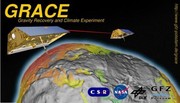Gravity Recovery and Climate Experiment (GRACE)

GRACE was a joint project between the National Aeronautics and Space Administration (NASA) and the Deutsches Zentrum für Luft- und Raumfahrt (DLR). The key partners of the Science Data System were the University of Texas Center for Space Research (CSR), the Jet Propulsion Laboratory (JPL), and the German Research Centre for Geosciences (GFZ).
The primary science objective of the GRACE mission was to measure the Earth’s gravity field and it’s time variability with unprecedented accuracy for a better understanding of Earth's water reservoirs over land, ice and oceans. The increase in accuracy has been achieved by utilizing two (twin) satellites following each other on the same orbital track. To consider precise attitude and non-gravitational forces both satellites were equipped with star cameras and accelerometers. The position and velocity of the satellites was measured using onboard GPS antennae and (for validation purposes) SLR retro-reflectors. Additionally, the twin satellites were interconnected by a K-band microwave link to measure the exact separation distance and its rate of change to an accuracy of better than 0.1 µm/s. These measurements are directly coupled to the seasonal and sub-seasonal variations in the continental hydrological cycle, to ice mass loss in the large glacier systems in Greenland or Antarctica, to long wavelength ocean circulation processes or to the transport of ocean heat to Earth’s poles. Consequently, since its launch in March 2002 until the end of science operations in June 2017 this fundamental dataset has enabled dramatic improvements of seasonal and inter-annual climate change estimates.
The secondary science objective of the GRACE mission was to obtain about 150 very precise globally distributed vertical temperature and humidity profiles of the atmosphere per day using the GPS radio occultation technique.
As mission lifetime of GRACE is limited, NASA and GFZ have implemented a GRACE-FO (Follow-on) mission which was successfully launched on 22 May 2018.
To get access via FTP to the different GRACE Level-1B (instrument and orbit data as well as atmosphere and ocean de-aliasing (AOD) model), Level-2 (gravity models in terms of spherical harmonic coefficients) and Level-3 (user-friendly gridded) data and documentation, (monthly) newsletters and various project related documentation please follow the link "GRACE Gravity Data and Documentation" on the left hand side. The link “News related to GRACE Gravity Data” provides further useful information on recent Level-1B and Level-2 data distribution. The Level-3 data provided at ISDC are based on the most recent GRACE data release from GFZ and are visualized and described at GFZ´s Gravity Information Service (GravIS).
